Ever smaller share of Hungarians feel the need for influenza shots

Confidence in vaccines declined since the COVID-19 pandemic
In Hungary, most childhood vaccinations included in the immunisation programme are mandatory and free of charge, resulting in a coverage rate of over 99%. However, uptake of voluntary adult vaccinations is low. In 2022, for example, only 22% of people over the age of 65 received a flu jab, the second lowest rate in the EU.
Globally, more than 1.5 million deaths occur each year from vaccine-preventable diseases, and these deaths could therefore be avoided. Meanwhile, the WHO estimates that childhood vaccinations prevent between 3.5 and 5 million deaths worldwide.
The difference may be due to the greater emphasis placed on mandatory vaccinations, compared to voluntary ones, which lack health information and therefore cause greater uncertainty,
according to Dr. Beatrix Oroszi, director of the Centre for Epidemiology and Surveillance at Semmelweis University,
According to their monthly surveys conducted between 2020 and 2022, confidence in the effectiveness and safety of the vaccines declined as the pandemic progressed. Although the health emergency has ended, the impact of this on vaccine hesitancy is still being felt.
The cross-sectional survey conducted in May 2025 examined attitudes toward COVID-19 and influenza vaccines, with a particular focus on differences in trust, misconceptions, the impact of misinformation, and its sources.
The method used was computer-assisted telephone interviewing, in which 1,500 randomly selected Hungarian adults were asked a short questionnaire based on the validated 7C model, supplemented with additional questions relevant to the current context.
40% of adults over the age of 60 said they would accept a vaccine for either flu or the new respiratory virus in the coming season. However, despite having visited their family doctor in the past 12 months,
25% and 35% of this age group did not receive the respective vaccines in the previous period, indicating a significant missed opportunity for vaccination.
Mistrust of vaccines is not merely an individual choice; it is a complex social and health policy challenge. To address this phenomenon, a coordinated approach is needed that combines scientific evidence with communication, education and community interventions. This must include strategies to combat misinformation and disinformation,
Oroszi stressed in a presentation for a recent training.
Flu vaccine uptake hits all-time low
Looking at the number of influenza-like illness cases per 100,000 people, we can see that the peak in the 2024/25 season was rather high. Only the peaks in the 2016/17 and 2014/15 seasons were higher; the former by quite a lot and the latter by a smaller amount. Read our closing report on the previous respiratory season here.
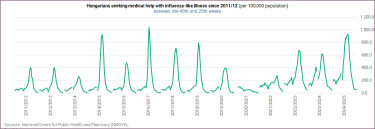
A total of 508,109 free-of-charge 3Fluart influenza vaccines were administered in Hungary in the 2024/2025 respiratory season, a period between the 40th and 20th weeks of two consecutive years that many (mistakenly) call the flu season.
This is the lowest number of flu shots received since 2010/2011.
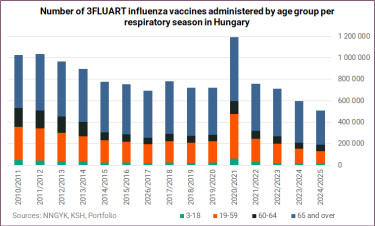
Given that the main risk group is people aged 60 and over, we have looked at how they felt about taking their chances against the flu without a jab.
The number of flu jabs administered to those aged 60 and over was at an all-time low of 376,780, which corresponded to 74.2% of all Hungarians vaccinated with the free 3Fluart shot, which marks just a small decrease from last year. This means that about three quarters of those asking for the free flu shot were aged 60 and over in the last respiratory season.
However, merely 14.9% of the 60+ age group felt the need to get the seasonal flu shot, which is
the lowest figure on record and way below the earliest comparable figure of 29.5% for the 2011/2012 season.
This means that out of 100 Hungarians aged 60 and over, only 15 felt the need to protect themselves against the flu via vaccination.
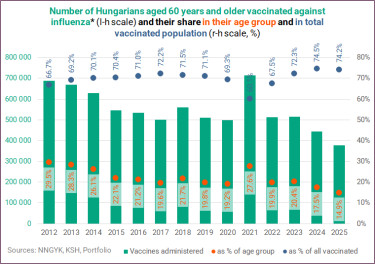
The rapidly waning willingness to get vaccinated against influenza is are even more dramatic when we look at the share of vaccinated Hungarians as a percentage of the (otherwise shrinking) population.
In the 2024/2025 respiratory season, merely 5.5% of Hungarians felt the need to get the free flu shot, the lowest share on record.
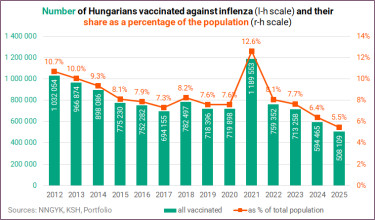
Free flu vaccines will also be available for the next flu season, with a total of 650,000 3Fluart doses earmarked for at-risk groups. These vaccines are expected to be available from general practitioners and occupational health services from mid-October 2025 onwards,
the NNGYK responded to our enquiry about the availability of flu shots in the current season. In the previous two season, 949,000 doses of the 3Fluart flu vaccine were available for the at-risk group of people aged 3 years and over.
Pertussis
When asked about the number of suspected pertussis cases, which are much lower now than a year ago, the NNGYK responded that its recommendations regarding pertussis vaccination remain unchanged; the guidelines issued in 2024 still apply.
In addition to the mandatory vaccination schedule, the vaccine is particularly recommended for pregnant women in their third trimester, ideally at least two weeks before their expected date of delivery.
Vaccination is not necessary if the expectant mother has already received a pertussis-containing vaccine as part of her family planning before becoming pregnant. Vaccinating immediate relatives and family members protects infants who are too young to be vaccinated by reducing the risk of infection.
"As immunity declines relatively rapidly after vaccination, the vaccine should be administered a few weeks or months before the birth of the child, or before a planned visit to a newborn or infant," it added.
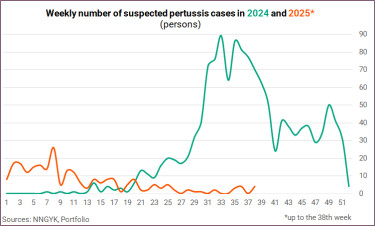
Hepatitis A
By the end of the 38th week, the NNGYK had recorded 1,238 cases of hepatitis A, which is by far the highest number since 2017 — at least as far as publicly available data go.
This is 2.4 times higher than the previous record of 518, which was reached in 2022, and higher than the previous three records combined.
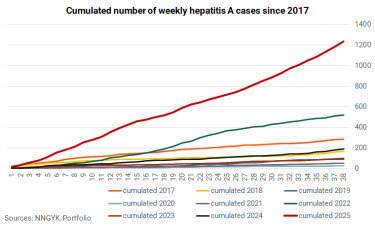
The NNGYK said
cases of hepatitis A in Hungary increase cyclically every five to seven years, which can be explained by a growing susceptible population due to a lack of natural immunity, coupled with the spread of the virus.
It noted that significant epidemics occurred between 2013 and 2015, followed by an increase in cases in 2022. Several factors contributed to this:
- firstly, an increase in cases was anticipated following the low numbers recorded in previous years (2020–21);
- secondly, a new virus strain (1B instead of the previously predominant 1A) emerged.
The virus spreads through faeces from infected individuals, through close contact between people living in the same household and through the shared use of toilets in communities. It can also be contracted through water, ice or food contaminated with faecal matter, or through food that has been touched by contaminated hands. In rare cases, the virus can be transmitted sexually.
The infection is more prevalent in areas with poor hygiene practices, where water purification and clean water supplies are unavailable.
Thorough hand washing and using antiviral (virucidal) disinfectants on surfaces such as sinks, toilets, door handles and light switches can reduce the risk of spreading the infection.
It is extremely important to follow proper hygiene rules to prevent infection.
In addition, vaccines are available from pharmacies on prescription.
Cover image (for illustration purposes only): Getty Images









